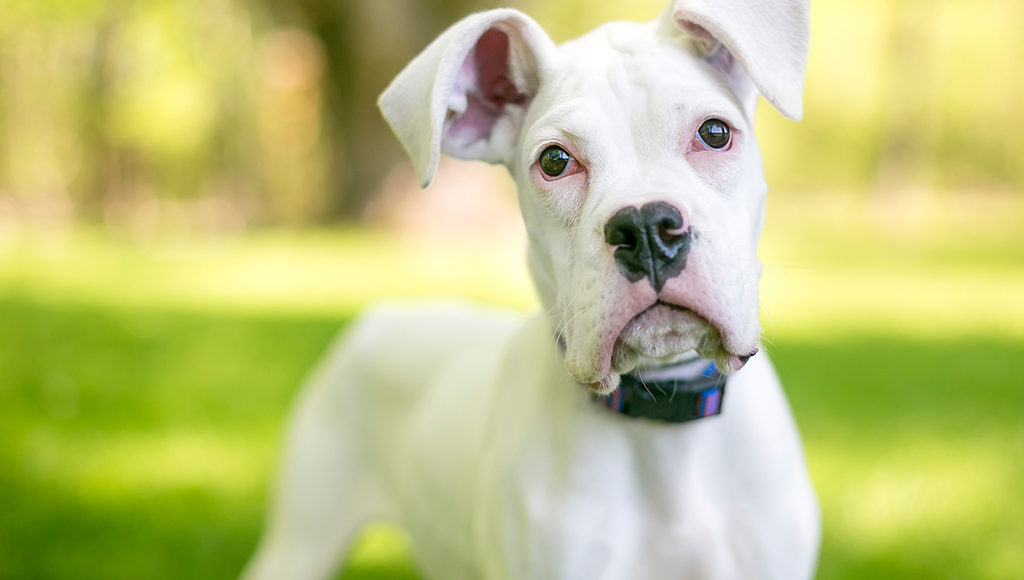Dispelling the Myths: Living with a Deaf Dog - Part I
Many negative warnings and stories surrounding deaf dogs simply aren't true.

Many of the negative warnings and stories surrounding deaf dogs simply aren't true. Each time deaf dogs are the topic of conversation, myths exchange from person-to-person as well. We will expose these myths using facts drawn from the actual experiences of those who share their lives with a deaf dog.
MYTH #1 - "Deaf dogs have permanent startle-aggressive personalities"
Deprived of the ability to hear, a deaf dog spends each day jumping out of it skin, startled by everything that crosses it's path. If you walk up behind a deaf dog, it startles it. If you touch a deaf dog when it's not looking at you, it startling and influencing it to bite you. If you wake a deaf dog when it's sleeping, it startles it and it will attack. Over time, these constantly startled dogs develop fearful, aggressive personalities and will bite or attack when startled for no reason.
Perhaps no other myth has caused more damage than this one. Its apparent logic is what makes it so seductive and easy to accept as fact with out question. This thought assumes that "being startled" is a permanent condition; that the deaf dog is perpetually startled, and will always respond by becoming fearful and aggressive. However, actual experiences from deaf dog owners tell a much different story.
The truth is deaf dogs adapt to their hearing loss and become comfortable with their surroundings. In the same way a hearing dog can be startled by a loud noise, you can startle a deaf dog with an unexpected touch. Owners report that their dogs' responses to an unexpected touch range from "YIKES!" (dogs may jump), to "huh?" (dogs simply turn and look). Some deaf dogs may experience momentarily disorientation when awakened, but few ever become aggressive or bite in response.
Furthermore, a deaf dog can learn to be less sensitive to the startle effect of unexpected touch or awakened from sleep. To accomplish this, walk up behind the dog when it isn't looking; touch the dog, then immediately pop a treat in the dog's mouth when it turns around. The dog quickly associates good things (i.e., the treat) with being touched unexpectedly, and learns to respond happily. Not all deaf dogs require this type of conditioning, but it is helpful for the more sensitive ones.
A deaf dog can also learn to wake easily in response to a gentle touch. Start slowly by first placing your hand in front of the sleeping dog's nose, which allows it to smell that you are near. Next lightly touch the dog on the shoulder or back, trying to touch only one or two hairs with your fingertips. Next gently stroke the dog with two fingertips, then with your entire hand. Most deaf dogs will awaken during some part of this exercise. When they open their eyes, their owner's smiling face, and perhaps even a treat, rewards them. In a matter of weeks, the dog becomes accustomed to waking up when the owner places a hand in front of its nose, or lightly touches its shoulder or back. Waking up becomes a gentle, positive experience for the dog.
Deaf dog owners do take special measures to alert their dogs to their presence before walking up to, or touching them. Many will wave their hands in the air, flip a light switch on and off, lightly blow on the back of the dog, or toss a ball or small stone near them; some owners simply wait until the dog turns toward them. The care that dog owners exercise in waking or walking up behind a deaf dog is not born from a fear of attack or bite. Instead, it is an act of compassion and love, which acknowledges the special needs of the dog.
Deaf dog owners don't work to raise a dog that will never react with surprise, but rather to condition the dog by teaching it to respond in a positive manner to unexpected events. The end result is a well-adjusted, happy dog.
MYTH #2 - "Deaf dogs should never live with children"
Homes with children should never house deaf dogs. They will startle and bite, they will become aggressive, and they will be hard to train. Therefore, they have no place in a home with children.
In truth, if a deaf dog is well socialized to human children, it is as safe to have in a home with children as any other dog. What is more important is the dog's history, its personality and any breed characteristics that affect how the dog reacts to small, quick-moving, and unpredictable humans. This is true for any dog - hearing or deaf.
If you are considering getting a dog, and you know children will be a central part of the dog's life, then do the research to find the best match for your situation and your family. Consider all the same factors you would if you were getting a hearing dog, such as size, breed temperament and personality, and the breed's genetic health factors.
Deaf dogs come in many sizes, shapes and colors. They are dogs first, representatives of their breed or mix second, and individuals third. All of the same factors considered when purchasing a hearing dog should carry more weight in making the decision than whether the dog is deaf.
For more accuracy, you can ask these reversed questions:
"I want to get a dog, but will my children fit in with my plan?"
"Can my children treat the dog gently and fairly at all times?"
"Will my children respect that the dog is not a human in a fur coat?"
"Will my children treat the dog like a living being and not a toy?"
"Will the children play with and be able to help train the dog?"
"Can I trust my children to keep the same rules for safety and good manners that I teach the dog?"
"Will my children bond with the dog and be a good companion?"
"Am I willing to supervise all interactions between the dog and my young children, until they grow up enough to be trusted around the dog without constant supervision?
These questions are just as important as any about the dog you want to bring home. The right deaf dog in a home with children can teach them a lot about dealing with someone who doesn't have the same abilities as them. Motivated children usually make wonderful dog trainers (even better than adults in many cases).
MYTH #3 - "Deaf dogs are more likely to be hit by a car"
Because a deaf dog cannot hear an approaching car, a honking horn, or its owner's verbal command, a deaf dog has a better chance of a car hitting it and dying than a hearing dog.
This myth implies that the majority of dog owners allow their dogs to roam, unsupervised, without a leash. While this may be true for a dog living on a 20-acre farm, it is certainly not true for a city-dwelling/suburban dog. In fact, most cities have leash laws prohibiting such activity. This myth also implies that the hearing dog has a survival advantage because it can hear the approaching car, and easily move out of its way. In reality, no dog is born knowing that the sound of an approaching car or honking horn is synonymous with pain and possible death.
Experience has shown that ANY dog wandering off leash, in close proximity to cars and roadways, is at risk. Even the best-trained hearing dog may run into a car's path if it’s chasing a cat or a squirrel. Because of this uncertainty, many dog owners do not allow their dogs off leash unless they are in an enclosed area. It is a cardinal rule of deaf dog ownership to NEVER allow the dog to roam off leash. A small percentage of rural deaf dog owners do allow their dogs off leash in certain circumstances, but they are definitely the exception. Most deaf dog owners simply never take the chance.
What about accidents? What if you drop the leash on your daily walk, or if your dog squeezes through an open door? Note that not all dogs bolt the minute they are free. The following exercise can condition any dog not to run if the leash is loose and dragging, or dropped. While walking your dog, let go of everything except the handle of the leash. Let the rest of the leash go slack and drag on the ground. If the dog tries to bolt, it receives a correction when it reaches the end of the leash. Eventually, your dog will pay no attention if the leash goes slack and drags on the ground.
You can also easily train a deaf dog to sit and wait before releasing it to walk through a door. One of the best ways to reinforce this is not to take the dog for a walk unless it sits and allows you to put on its leash. The dog quickly learns "no sit, no leash, no walk." Deaf dog owners have also reported success in using a vibrating collar as a signal for the dog to come.
We will continue this series in next month's newsletter!
Ready to start saving money on pet wellness care?
Then take a look at Mint Wellness, the pet wellness plan that provides fast reimbursement on routine pet care. Save on vaccinations, wellness exams, preventatives, dental, and more!
Learn More


